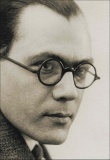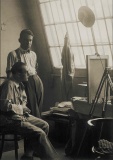School of Arts and Crafts, Bratislava

School of Arts and Crafts [Škola umeleckých remesiel (ŠUR)] was a vocational school in Bratislava that combined crafts and the fine arts. It operated in the interwar period, from 1928 to 1939.
School of Arts and Crafts [Škola umeleckých remesiel] (1928-1939) was founded on initiative of Josef Vydra in Bratislava with support from the Chamber of Commerce and Industry to provide evening courses in drawing and advertising. In 1930 it merged with Učňovské školy, and included departments for painting, fashion and textile design, metal, wood, ceramics, photography, graphic art, retail design, and film. It quickly became one of the most progressive educational institutions in the arts and crafts in Europe during the interwar period. Studies in specialized departments were preceded by preliminary elementary courses in drawing, surface and space composition, colour harmony, modeling and lettering. In reality, this already involved an application of the Bauhaus method. The school's intention was also to integrate folk craft traditions in modern production. The teachers included avant-garde artists Ľudovít Fulla, Mikuláš Galanda, Jaromír Funke or Zdeněk Rossmann, guest lectures were delivered by László Moholy-Nagy, Jan Tschichold, Kállai, Hannes Meyer and others. They drew their inspiration from Analytical Realism, Constructivism and the poetic fantasy of children's art - combining all these influences with a high level of craft skills and with folk art traditions. In mid-1930s the school was attended by 200 students and the teaching staff counted some twenty members. The students were of Slovak, Czech, German and Hungarian nationalities and they also came from Poland, Yugoslavia, Germany and Bulgaria. After the Czech professors were forced to leave Slovakia, Vydra persuaded Fulla to take up the direction of the School, hoping to preserve continuity of its orientation. However, the school operated only for another 10 months. On 1 October 1939, the School of Applied Arts was closed.
Departments and their heads[edit]
- Field drawing and composition [Plošné kreslenie a kompozícia; Plošná kompozícia; Priestorová kompozícia a kreslenie]
- Josef Vydra (1928-31)
- Decorative drawing [Dekoratívne a grafické kreslenie; Dekoratívne kreslenie a kompozícia]
- Ľudovít Fulla (1928-30)
- Figural drawing [Figurálne kreslenie]
- Gustáv Mallý (1928-29)
- Ľudovít Fulla (1929-34)
- Janko Alexy (1929-30)
- Graphic art [Oddelenie grafické]
- Karel Štika (1929-31)
- Zdeněk Rossmann (1931-38). With him, Vydra school's impact had grown considerably and within two years its influence had penetrated several Slovak printing presses. During his stay in Bratislava he prepared a book on the utilization of lettering and photography in advertising, published as Písmo a fotografie v reklamě, Index, Olomouc, 1938. He also worked at Slovenská grafia and nová bratislava magazines.
- Fashion and textile design [Oddelenie módy a textilu]
- František Malý (1929-38)
- Preparatory youth courses (8-14 years) [Kurz umenia pre mládež; Detský kurz]
- Janko Alexy (1929-30)
- Mikuláš Galanda (1930-38)
- Painting [Oddelenie maliarske]
- Ľudovít Fulla (1930-38)
- Many courses were taught by Mikuláš Galanda.
- Perspective and space drawing [Perspektíva a priestorové kreslenie]
- Ferdinand Hrozinka (1930-31)
- Drawing [Všeobecné oddelenie kresby]
- Mikuláš Galanda (1930-31)
- Typography [Písmo]
- Adolf Petříček (1930-31)
- Modeling [Modelovanie]
- Miroslav Motoška (1930-31)
- Contemporary taste [Prednášky o dobovom vkuse]
- Antonín Hořejš (1930-31)
- Photography [Oddelenie fotografické]
- Jaromír Funke (1931-Feb 1935). He considered studying at the Bauhaus, but in the end gave priority to teaching in Bratislava.
- Ladislav Kožehuba (Feb 1935-39)
- Retail design [Oddelenie aranžovania výkladných skríň; Aranžérsky kurz; Oddelenie aranžovania]
- Mikuláš Galanda (1931-32, 1936-37)
- František Reichentál (1932-38)
- František Tröster (1937-38)
- Ceramics [Oddelenie keramické]
- Júlia Horová (1931-38).
- Wood workshop [Oddelenie drevorobné]
- Ferdinand Hrozinka (1931-38)
- Metal workshop [Oddelenie kovorobné]
- František Knajfl (1933-34)
- František Tröster (1934-37)
- Josef Vinecký (2937-38)
- Figural modeling [Figurálne modelovanie]
- Júlia Horová (1933-34)
- Film [Oddelenie filmové]
- Karol Plicka (1938-39). Plicka came during the last years of the School's existence, 16 students subscribed to his workshop. Later in 1938 in Bratislava he opened the first film school in Czechoslovakia.
Images[edit]
Ľudovít Fulla and Mikuláš Galanda in their studio on Trnavská street, Bratislava, early 1930s. (2)
Literature[edit]
Books[edit]
- Susanne Anna (ed.), Das Bauhaus im Osten: Slowakische und tschechische Avantgarde 1928-1939, Ostfildern-Ruit: Hatje Cantz, et al., 1997, 339 pp. Publisher. TOC. Preview. Review. (German)
- Iva Mojžišová, Škola moderného videnia - bratislavská ŠUR 1928-1939, Bratislava: Artforum, and Slovak Design Center, 2013, 216 pp. Publisher. Publisher. Excerpt, Excerpt. (Slovak)
- Simona Bérešová, Klára Prešnajderová, Sonia de Puineuf (eds.), School as a Laboratory of Modern Life: On the Reform of Art Education in Central Europe (1900–1945) / Škola ako laboratórium moderného života / Schule als Laboratorium des modernen Lebens, Bratislava: Slovak Design Centre, 2020, 277 pp. (English),(Slovak),(German)
- Škola ako laboratórium moderného života. Reforma umeleckého školstva v strednej Európe (1900-1945), Bratislava: Slovenské centrum dizajnu, 2020, 87 pp. (Slovak)
- Klára Prešnajderová, Simona Bérešová, Sonia de Puineuf (eds.), ŠUR. Škola umeleckých remesiel v Bratislave, 1928-1939, Bratislava: Slovenské centrum dizajnu, and Bratislava: Slovart, 2022, 432 pp. Publisher. (Slovak)
Essays[edit]
- Ľudovít Kudlák, "Z prednášok Ladislava Moholy-Nagya na Škole umeleckých remesiel", in Výročná zpráva odborných učňovských škôl v Bratislave, 1933-1934, 1934. (Slovak)
- Francis A. Taylor, "Art Training for Industry on the Continent", Journal of the Royal Society of Arts 84:4332 (29 Nov 1935), pp 64-87. [1] (English)
- "Současné školy umění a řemesel na kontinente", Výtvarná výchova 2:3 (1936), Prague, pp 11-29. (Czech)
- Josef Vydra, "Počiatky prvej umeleckej školy na Slovensku. 30 rokov od založenia Školy umeleckých remesiel v Bratislave", Výtvarný život 3:8 (1958), Bratislava, p 300. (Slovak)
- Ľudovít Kudlák, "Rozpomienky na ŠUR v Bratislave", Výtvarný život 3:5 (1958), Bratislava, p 301. (Slovak)
- Ars 3:2 "Výtvarné avantgardy a dnešok", Bratislava: Slovak Academy of Sciences, 1969. Proceedings from an international conference held at Smolenice, 12-14 June 1968. Papers by Irena Blühová, Júlia Horová, Iva Mojžišová, František Reichenthal, Tomáš Štrauss, Eduard Toran, Marian Váross, Hans Maria Wingler, et al. [2] (Slovak)
- Tomáš Štrauss, "Slovenský variant moderny (ŠUR Bratislava 1928-1938)", Umění a remesla 3 (1978), pp 10-19. (Slovak)
- "Die slowakische Variante der Moderne : Bratislava im Zeichen von WCHUTEMAS und Bauhaus", Wissenschaftliche Zeitschrift der Hochschule Architektur und Bauwesen 26:4-5 (1979), Weimar, pp 405-413. Talk given at Bauhauskolloquium in June 1979 in Weimar. [3] (German)
- Fero Tomík, "J. Funke a ŠUR v Bratislave", in Aktuálnost československé meziválečné fotografie, Brno: Dům umění města Brna, 1979, pp 54-61. (Czech)
- Maria Pötzl-Malikova, "Die Kunstgewerbeschule in Preßburg 1928-1939. Zur Ausstrahlung der Bauhaus-Ideen in der Slowakei", Vorträge der Tagungen des Collegium Carolinum Bad Wiesse vom 23. bis 25. November 1979 und vom 28. bis 30. November 1980, Munich/Vienna: R. Oldenbourg, 1982, pp 201-324. (German)
- Iva Mojžišová, "Die personliche Beziehungen zwischen den Angehörigen des Bauhauses und der Kunstgewerbeschule in Bratislava in Lichte neuentdeckter Dokumente", in Wissenschaftliche Zeitschrift der Hochschule fur Architektur Bauwesen Weimar 33:4-5-6 (1987), pp 335-338. Talk given at 4. internationales Bauhauskolloquium in Jun 1986. [4] (German)
- Iva Mojžišová, "Škola umeleckých remesiel v Bratislave a Bauhaus", Ars 23:2 (1990), Bratislava, pp 43-54. [5] (Slovak)
- Iva Mojžišová, "Avant-Garde Repercussions and the School of Applied Arts in Bratislava, 1928-1939", Journal of Design History 5:4 (1992), pp 273-279. (English)
- Iva Mojžišová, "Osobné vzťahy medzi členmi Bauhausu a Školy umeleckých remesiel v Bratislave vo svetle novonájdených dokumentov", Profil (1993), Bratislava, pp 1-2. (Slovak)
- Iva Mojžišová, "ŠUR a moderna", in Dejiny slovenského výtvarného umenia – 20. storočie, ed. Zora Rusinová, Bratislava: Slovak National Gallery, 2000, pp 18-25. (Slovak)
- "Modernism and the School of Arts and Crafts in Bratislava", in A Reader in East-Central European Modernism, 1918-1956, eds. Beata Hock, Klara Kemp-Welch, and Jonathan Owen, London: Courtauld Books Online, 2019. (English)
Exhibitions[edit]
- Škola moderného videnia - bratislavská ŠUR 1928-1939, Múzeum mesta Bratislavy (MMB), Bratislava, 2 Jul-1 Sep 2013. Organised by FOTOFO and MMB. [6] [7]
- Have No Fear of Modernism: 90th Anniversary of the Establishment of the School of Arts and Crafts in Bratislava, Bratislava Castle/SNM – Museum of History, Bratislava, 14 Dec 2018-29 Sep 2019. With companion website. (Slovak)/(English)
See also[edit]
- Josef Vydra
- Slovenská grafia
- Slovakia#Interwar avant-garde
- Central and Eastern Europe#Constructivists, Futurists
Links[edit]
- School of Arts and Crafts (building) at Slovak Wikipedia
- http://www.slovakia.culturalprofiles.net/?id=-13068
- http://www.suvba.eu/historia.html
- http://www.register.ustarch.sav.sk/index.php/en/architect/110-balan-alois/519-kola-umeleckych-remesiel
| Art and design schools | ||
|---|---|---|
|
Bauhaus (Weimar, Dessau, Berlin, 1919-1933), Vitebsk Popular Art Institute (Vitebsk, 1919-1922), VkHUTEMAS (Moscow, 1920-1926), School of Arts and Crafts (Bratislava, 1928-1939), Black Mountain College (Black Mountain, NC, 1933-1957), Ulm School of Design (Ulm, 1953-1968), École de recherche graphique (Brussels, est. 1972), Piet Zwart Institute (Rotterdam, est. 2001) | ||






